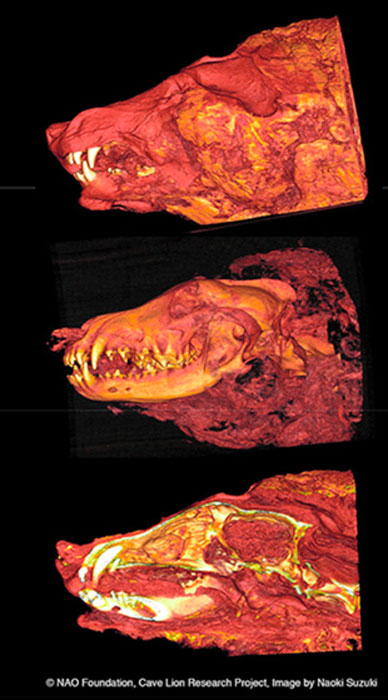
Still Snarling After 40,000 Years, a Giant Pleistocene Wolf Discovered in Yakutia
By: The Siberian Times reporter
Reports of a the sensational find of head of a toothy beast with its brain intact that has been preserved since prehistoric times in permafrost, have been a delight for archaeologists and the like. The severed head of the world’s first full-sized Pleistocene wolf was unearthed in the Abyisky district in the north of Yakutia.
The Discovery of the Pleistocene Wolf
A local man, Pavel Efimov, found it in the summer of 2018 on the shore of the Tirekhtyakh River, a tributary of Indigirka. The wolf, whose rich, mammoth-like fur and impressive fangs are still intact, was fully grown and aged from two to four years old when it died.

Local man Pavel Efimov found the Pleistocene wolf’s head. (Siberian Times)
The head was dated as older than 40,000 years by Japanese scientists. Scientists at the Swedish Museum of Natural History will examine the Pleistocene predator’s DNA.
The Pleistocene Wolf Is Extremely Well Preserved
“This is a unique discovery of the first ever remains of a fully grown Pleistocene wolf with its tissue preserved. We will be comparing it to modern-day wolves to understand how the species has evolved and to reconstruct its appearance,” said an excited Albert Protopopov, from the Republic of Sakha Academy of Sciences.
The Pleistocene wolf’s head is 40 centimeters (16 inches) long, so half of the whole body length of a modern wolf which varies from 66 to 86 centimeters (26 – 39 inches). This is a unique discovery of the first ever remains of a fully grown Pleistocene wolf with its tissue preserved.
- Fantastic Beasts and Where to Find Them: A History of Monsters, from Werewolves to Hippogriffs
- Pleistocene Skull and 300,000 Years of Evolution Secrets Found in a Chinese Cave
- Ancient Bones of Mystery Creature Dug up by Children in Yakutian Village

The Pleistocene wolf was still snarling after 40,000 years. (Naoki Suzuki / Fair Use)
The astonishing discovery was announced in Tokyo, Japan, during the opening of a grandiose Woolly Mammoth exhibition organized by Yakutian and Japanese scientists.
The Study of the Ancient DNA
Alongside the wolf the scientists presented an immaculately-well preserved cave lion cub.
“Their muscles, organs and brains are in good condition,” said Naoki Suzuki, a professor of palaeontology and medicine with the Jikei University School of Medicine in Tokyo, who studied the remains with a CT scanner, “We want to assess their physical capabilities and ecology by comparing them with the lions and wolves of today.”

CT scan of the wolf's head. (Naoki Suzuki / Fair Use)
The cave lion cub named Spartak, which had been announced previously, is about 40 centimeters (16 inches) long and weighed about 800 grams (1.8 pounds). Scientists believe the cub died shortly after birth.

The cave lion cub found with the Pleistocene wolf’s head. (Valery Plotnikov / Fair Use)
The recent discovery follows that of the remains of three cave lions in 2015 and 2017 by the same team.
Top image: The Pleistocene wolf’s head discovered in Yakutia. Source: Albert Protopopov / Fair Use.
The article ‘Still snarling after 40,000 years, a giant Pleistocene wolf discovered in Yakutia’ originally appeared on The Siberian Times and has been republished with permission.
















Comments
So what I’m wondering is what kind of wolf it actually is! It’s obviously not a gray Wolf and very unlikely it’s a dire wolf because of it’s huge size. Dire wolves were around the same size as a large timber wolf, only more muscular and with thicker bones. This wolf, whatever it is, was about the size of a horse.
So the lion cub died shortly after birth and the cub's entire corpse is still intact, but what event separated the wolf's head from its body and what was the wolf's cause of death 40,000-years ago?